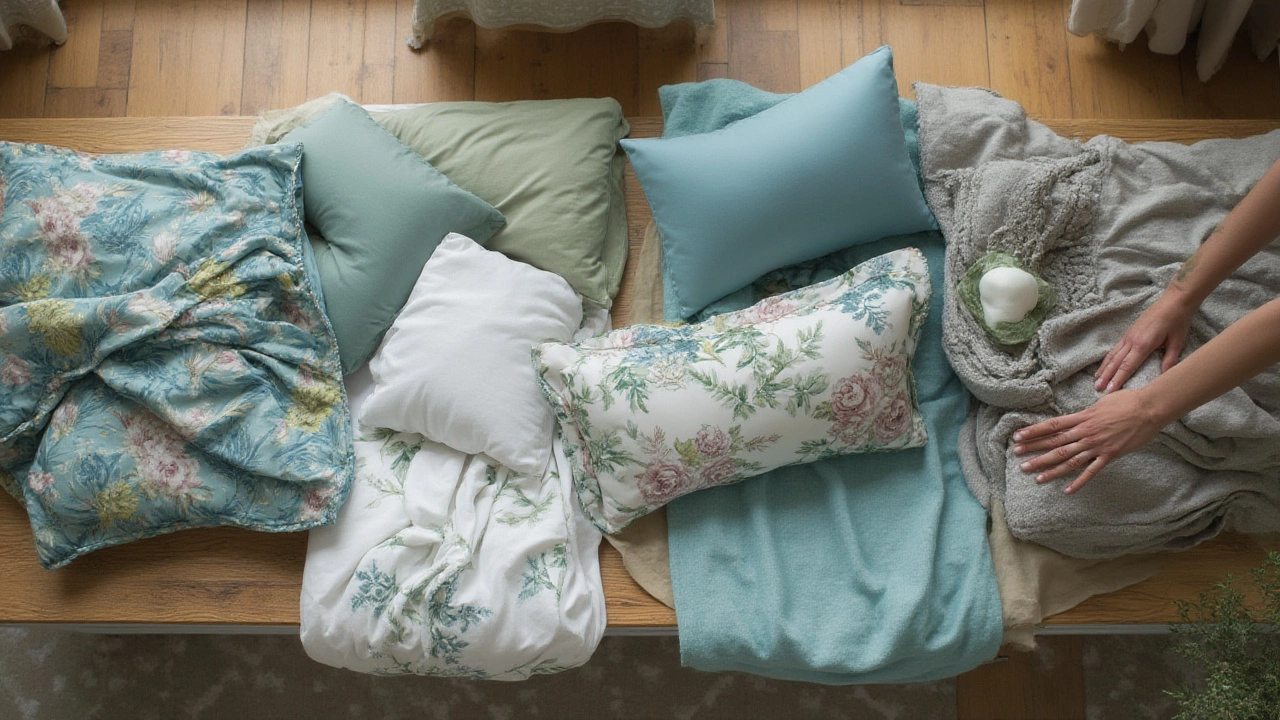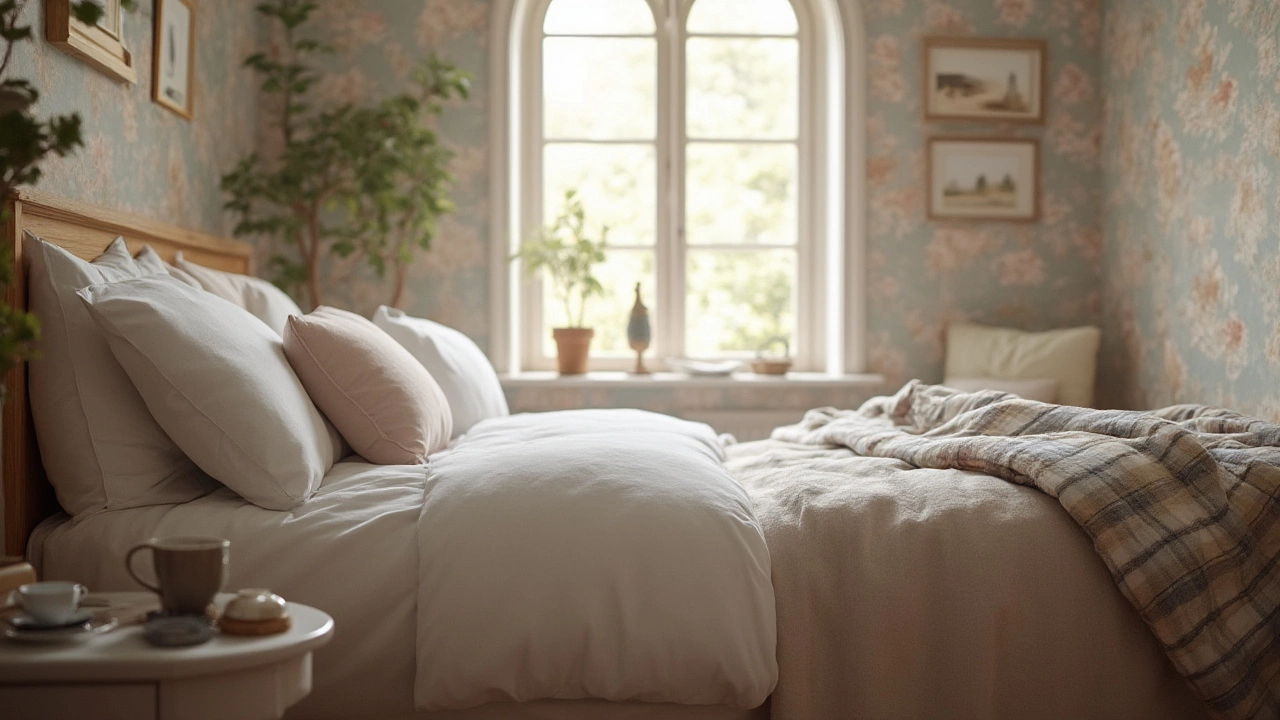Imagine walking into a hotel room after a long day, pulling back crisp sheets, and sinking into a bed that just feels right. That feeling? It’s all about the bedding. People talk about getting a good night's rest like it's some mysterious science, but a huge part boils down to what’s covering your mattress. The word 'bedding' might sound ridiculously simple, but believe it or not, lots of people are a bit fuzzy about what it actually includes. Some folks only think of sheets. Others picture those fluffy duvets piled high like in glossy catalogues. And then there’s the blanket debate—is it bedding or just an accessory? There's more to bedding than you’d expect, and getting it right can make a real difference in how you feel when you wake up.
What Does Bedding Actually Mean?
You see the word 'bedding' tossed around everywhere—in shops, online ads, and interior design magazines. So, what does it cover? In simple terms, bedding includes all the items that go on top of your mattress. It’s what you sleep under, snuggle with, and sometimes kick off onto the floor by morning. Traditionally, bedding means all those soft pieces: sheets, pillowcases, blankets, comforters, and duvets. And don’t forget the mattress protector, which keeps your mattress clean and lasts longer. The term pops up in both British and American English, with only slight differences in what gets counted. In the UK (where I live), ‘bedding’ often means the basics like fitted sheets, flat sheets (also called top sheets), duvet covers, pillowcases, and maybe a blanket or two. In the US, the term tends to stretch even further, throwing 'bed skirts,' 'shams,' and 'quilts' into the mix. Fun fact: dictionaries such as the Oxford English Dictionary define bedding as 'bedclothes collectively,' which basically means all the removable washable fabric you use to make a bed comfortable and hygienic. It doesn't include the bed itself or your mattress—just the layers that you swap out to keep things fresh.
If you ever get lost in a maze of shop aisles, you’ll often see bedding arranged by type and by size. The industry, not surprisingly, tries to upsell with matching sets—think of perfectly coordinated pillow shams, runners, and even little cushions that look pretty but somehow always end up on the floor. At its heart, though, bedding’s job is simple: make your bed a clean, cosy, inviting place to rest. And yes, the right bedding can genuinely improve your sleep, as claimed by the Sleep Foundation—clean, comfortable bedding has been shown to help people sleep better and feel more rested.
Types of Bedding: What's in the Set?
Bedding’s not a one-size-fits-all deal. There are lots of pieces, each with its own role in turning a plain mattress into a snuggly retreat. Here’s a breakdown of the main types of bedding you’ll come across, with tips about what they do and why you might want (or not want) them on your bed:
- Sheets: Every bed starts with a bottom sheet, usually a fitted one that hugs the mattress. Then you’ve got your top sheet, which sits between you and your duvet or blanket. In winter, people sometimes go for flannel sheets; summer usually calls for pure, breathable cotton.
- Pillowcases: These keep your pillow clean and soft against your skin. They come as part of most sets.
- Duvet covers: In the UK, most people use a duvet insert (sort of like a thick, soft quilt) with a washable cover. In the US, comforters—sewn shut covers—are more common.
- Blankets: Layers for extra warmth. Wool, fleece, or cotton—everyone has a favourite.
- Mattress protectors: Not glamorous, but they save your mattress from spills, sweat, and other unlucky accidents.
- Throws and bedspreads: For a decorative finish, or for an extra snuggle when it’s cold.
- Bed skirts (mainly US): Hide the storage space or the legs of your bed, and make everything look neat.
For anyone putting together a new bedroom,
| Item | Function | Usual Material |
|---|---|---|
| Fitted Sheet | Protects mattress, adds comfort | Cotton, Microfibre |
| Top Sheet | Barrier between sleeper and cover | Cotton, Linen |
| Pillowcase | Covers pillow | Cotton, Silk |
| Duvet Cover | Protects duvet insert, style | Cotton, Polyester |
| Blanket | Extra warmth | Wool, Fleece |
| Mattress Protector | Keeps mattress clean | Cotton, Waterproof Membrane |

How Words and Trends Around Bedding Evolve
Bedding has a real cultural side to it that people don’t always notice. How we talk about our beds and what we put on them says a lot about trends, comfort, and even our cleaning habits. For one, the language of bedding keeps evolving. Take the US vs the UK—Americans call the top layer a 'comforter,' while in Britain, we stick with 'duvet.' Even the term 'bedding' itself has changed over the years. Back in the day, people just spoke about 'bedclothes.' The rise of Instagram-worthy bedrooms has turned bedding into a fashion statement. According to a report in The Guardian, Google searches for 'linen bedding' jumped by 245% in a year, proving that trends can really drive what goes on our beds. Hotels and influencers now set styles, with fancy linens, decorative pillows, and even seasonal 'refreshes.' There’s this whole 'bedscape' thing—layers, textures, and colours designed to make your bed look perfect, not just feel good.
But bedding isn’t just about cosiness or Instagram likes. It’s got a practical purpose—keeping everything clean, regulating temperature, and making the room look finished. Somewhere in the mix, words like 'hygge' (that Danish sense of comfort), 'thread count,' and even 'eco-friendly bedding' have crept into our daily conversations. Today you’ll find bamboo bedding, eucalyptus sheets, and bedding made from recycled materials. Sustainability really does matter—one Statista report said that by 2024, over half of consumers in the UK were looking for some kind of eco-friendly or organic bedding option. If you’re choosing for children or anyone with sensitive skin, labels like 'Oeko-Tex Certified' or 'GOTS Certified' mean your bedding is tested for harmful substances.
How to Choose the Right Bedding for Your Needs
Settling for any old sheets can be a real mistake. The right bedding can make nights cooler or warmer, keep your allergies under control, and help you wake up ready for the day. Start by thinking about the climate you live in. Here in Bristol, summers can be muggy and winters are freezing, so it’s smart to have light cotton bedding for summer and thicker, layered options for winter. Thread count matters, but the material is even bigger. A high thread count 100% cotton sheet always feels crisp, but if you need something that dries quickly, go for microfibre. Natural linen gets softer the more you wash it and is getting really popular, especially for those looking for a bit of French farmhouse chic in their homes.
Allergies? Consider anti-allergen or hypoallergenic bedding. Many shops now sell pillow and mattress protectors specifically designed for sufferers, and it’s become much more common to see bedding treated to stop dust mites and bacteria. If you have sensitive skin, try organic cotton—it’s grown without nasty chemicals, and lots of people say it feels better.
"Good bedding is one of the easiest ways to improve your quality of sleep. It’s a small investment for a big return,"says Dr. Sophie Bostock, an expert in sleep health. She recommends washing all bedding at least once every two weeks at 60°C to kill dust mites and bacteria.
Here are some quick tips for choosing bedding:
- Feel the fabric before you buy if you can. If it scratches the back of your hand, it’ll drive you mad on your legs.
- Look for deep pocket sheets if you have a thick mattress or a mattress topper.
- Don’t ignore care instructions—some luxury cottons or silk need extra gentle washing.
- If you sweat at night, try moisture-wicking materials like bamboo or special performance microfibres.
- Coordinate colours for a calm look, or mix and match prints and plains for personality.
Don’t just think about looks—a beautiful bed you hate sleeping in isn’t a win. If you need inspiration, browse home stores after feeling some samples. And when buying online, always check user reviews for hints about comfort and durability.

Bedding Hacks: Keeping Things Fresh and Comfortable
Want that five-star hotel feeling every night? Getting your bedding right is step one, but taking care of it is just as important. People often make a basic mistake: washing bedding too rarely, which can make even the fanciest sheets feel flat and, worse, a bit grimy. According to a 2024 survey by the UK Sleep Institute, 42% of Brits wash their sheets only every two or three weeks. That’s not great—skin cells, sweat, and dust mites build up much faster than you think. Doctors recommend changing pillowcases weekly and sheets at least every two weeks, more often if you sweat a lot or have pets that jump on the bed. Always wash sheets and bedding at the highest safe temperature (usually around 60°C for most cotton). Use gentle, fragrance-free detergents if you have sensitive skin.
Pro tip: line dry your bedding outside on a sunny day. The UV rays actually kill bacteria and make things smell surprisingly fresh. In colder months, tumble drying with a clean tennis ball or dryer ball keeps duvets fluffy and helps avoid that lumpy look. To boost the scent, pop a lavender pouch in your linen cupboard! If you ever spill tea (British problems) or coffee on your sheets, treat the stain straight away with cold water. Hot water can set stains, which nobody wants to see gleaming back at them first thing in the morning.
Every few months, deep clean duvet inserts and pillows. Many can be popped into a large washing machine; just check the label. If they’re too big for your machine, head to a laundrette—it’s worth it for fresher, fluffier bedding. It’s also smart to rotate your bedding sets, so each one lasts longer and wears out evenly. Keep seasonal bedding stored in breathable cotton bags, not plastic, to avoid that musty wardrobe smell. Every autumn, inspect your bedding for signs of wear—holes, thinning fabric, flattened pillows can all signal it’s time to upgrade.
Here’s a common dilemma: How often should you buy new bedding? Most experts suggest replacing pillowcases and fitted sheets every two years, duvets and pillows every five years (or sooner if they’re stained or sagging). Look after your bedding and it’ll look after you, sleep after sleep.
If you ever doubted how much bedding matters, remember—the right set can turn a rubbish day around, sneak some style into your bedroom, and actually help you sleep better. Your bed is more than a mattress; it’s a place to recharge, hide from the world, and just feel good. Next time you crawl under the covers, you’ll know every layer, from the first sheet to the final throw, plays its part. Sweet dreams!

